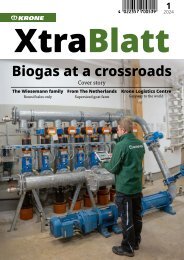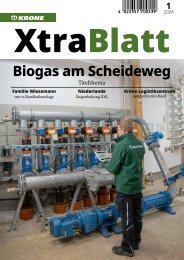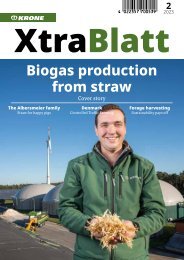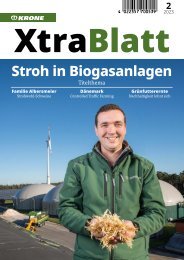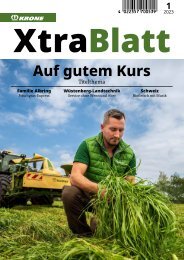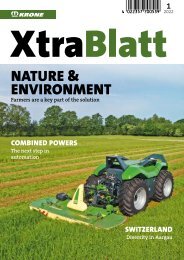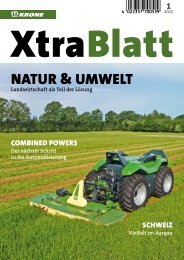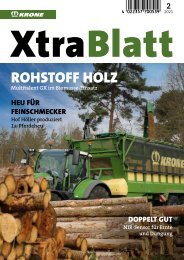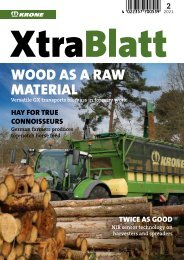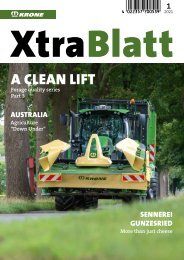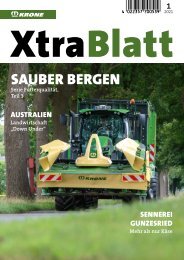XtraBlatt Issue 01-2023
You also want an ePaper? Increase the reach of your titles
YUMPU automatically turns print PDFs into web optimized ePapers that Google loves.
The forage wagon<br />
delivers fresh grass to<br />
one side of the feed<br />
passage, then turns<br />
around and delivers it<br />
to the other side on its<br />
return.<br />
The economic<br />
benefits<br />
of feeding<br />
fresh<br />
grass are<br />
obvious.<br />
André Albring,<br />
farmer<br />
In 2022, the Albring<br />
farm took delivery of a<br />
pre-production mower<br />
model with cross<br />
feeding auger.<br />
“I can’t use a tedder if I want to feed fresh grass<br />
and I set the bar very high when it comes to forage<br />
cleanliness, which is why I need an auger. But<br />
here too, Krone was very flexible and provided me<br />
with a pre-production model at short notice. So<br />
our harvesting method proved a win-win for both<br />
sides,” he adds with satisfaction.<br />
Stepped cuts<br />
On the subject of cut-and-carry forage quality, André<br />
Albring raises the question of cutting height.<br />
For him, 8cm is the absolute lower limit, ideally<br />
10cm. There are two reasons for this; firstly, there<br />
is less risk of forage contamination and secondly,<br />
regrowth starts sooner. When it comes to blade<br />
length, he aims for 14–15cm wherever possible, and<br />
maximum 22cm. In his experience, forage intake is<br />
best at this length. If the grass inadvertently grows<br />
taller, he prefers to ensile it.<br />
The cutting cycle can be very challenging in Ihorst<br />
because the soil conditions are so variable – they<br />
have everything from peaty subsoil and peaty sand<br />
to sand and smaller plots with “heavier” soils. “If all<br />
conditions are met, the grass continually regrows<br />
in such a way that the field looks like a flight of<br />
steps and after around 20 days we go back to step<br />
one and start all over,” he outlines the optimal<br />
situation. Fertiliser is also applied in a similar<br />
patchwork fashion. The slurry is separated in the<br />
farm’s own plant and some of the solid fraction is<br />
used as litter, while the liquid fraction is spread on<br />
the grassland with their own tanker and trailing<br />
shoe injector according to the cutting cycle.<br />
And how does harvesting fresh grass fit in with<br />
the overall grassland management system? Grass<br />
silage is still a major component of the feed ration.<br />
A quick look at the farm’s figures helps to illustrate<br />
the situation: the Albrings farm around 230ha of<br />
land altogether, of which 50ha is arable, mainly<br />
down to maize. Of the 180ha of grassland, 25ha<br />
can only be used extensively due to the peaty<br />
soil; here the Albrings take the first cut for hay<br />
for their calves and a second cut for silage or cutand-carry.<br />
In the spring they use around 35ha of<br />
the remaining 155ha of grassland for cut-and-carry<br />
in the spring and take a first and second cut silage<br />
from the rest.<br />
The proportion of cut-and-carry increases significantly<br />
in the summer months, and here the<br />
amount of rainfall is an important factor. Too<br />
much water is particularly problematic, because<br />
it makes the land more difficult to drive on and<br />
also impairs the forage quality. On the other hand,<br />
too little rainfall, as was the case in the summer<br />
of 2022, can leave them with no fresh grass at all.<br />
“Although that’s unfortunate, it’s not usually a<br />
disaster. Where possible, we try to ensure that we<br />
always have enough forage for at least one and a<br />
half years – so we can easily ride out shortages,”<br />
explains André Albring.<br />
If you’ve been paying attention and are wondering<br />
how you can feed and maintain the performance<br />
of 480 cows plus offspring – 900 animals in total<br />
– from 230ha of land, you’ll understand when you<br />
learn that the Albrings buy in maize from other<br />
local farmers every year. These take their slurry in<br />
return. Furthermore, the Albring family can make<br />
use of the 3rd and 4th cut from neighbouring farmers<br />
who don’t want to use this forage themselves.<br />
“It’s often not worth using it for silage, but for<br />
feeding fresh grass it’s really good,” André Albring<br />
explains. As he sees it, one advantage of the late cut<br />
is that this way the grass is not too long as the fields<br />
go into winter. In his experience, the grass sward<br />
can get off to a better start the following spring, if<br />
properly managed.<br />
Fresh grass instead of soya<br />
Experience is key: originally from the Netherlands,<br />
Monique and André Albring carved a new life<br />
for themselves as farmers in Ihorst when they<br />
acquired the farm in 2000. “My brother runs<br />
the family farm near Stadskanaal in the Dutch<br />
province of Drenthe and has long been an advocate<br />
of feeding fresh grass – like many other farmers in<br />
the Netherlands. The advisory bodies there are also<br />
well-acquainted with this method and can provide<br />
farmers with specialist help. Unfortunately, in my<br />
experience it’s not like that in Germany, which I<br />
think is a shame, because the economic benefits of<br />
feeding fresh grass are obvious,” he says – turning<br />
the conversation back to the three advantages<br />
mentioned at the beginning relating to ration<br />
formulation. <br />
André Albring finds<br />
that 22–25cm is the<br />
ideal growth height of<br />
fresh grass and that<br />
30cm is the maximum.<br />
The stubble length<br />
should be between<br />
8 and 10cm to avoid<br />
forage contamination.<br />
48 1|<strong>2023</strong> <strong>XtraBlatt</strong><br />
<strong>XtraBlatt</strong> 1|<strong>2023</strong><br />
49



